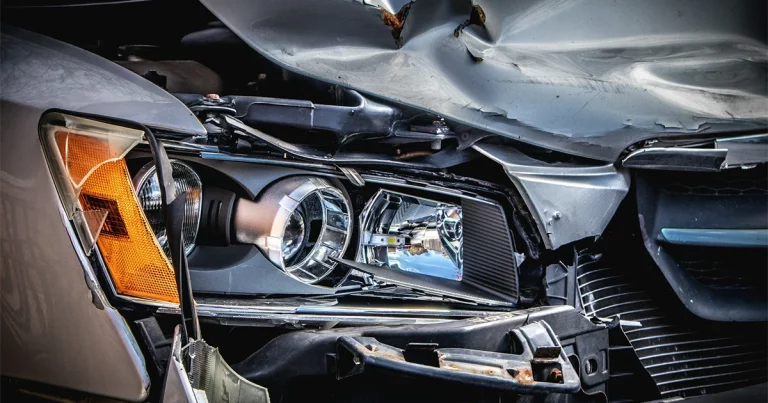Motorcycle accidents are a frequent and disproportionately deadly part of U.S. road trauma. Motorcyclists represent a small share of total vehicle miles traveled yet account for a large share of traffic deaths. Understanding how common motorcycle accidents are, what usually causes them, and what the odds look like can help riders and drivers stay safer on American roads.

How common are motorcycle accidents?
Motorcycle accidents are relatively common compared with other vehicle crash types when measured per mile traveled. In 2023, 6,335 motorcyclists were killed in crashes — the highest annual number on record — and thousands more were injured.
Per 100 million vehicle miles traveled in 2023, the motorcycle fatality rate was 31.39, nearly 28 times the passenger-car occupant fatality rate. These figures show that motorcyclists face much higher exposure to severe outcomes when crashes occur.
Motorcycle Fatalities vs. Passenger-Vehicle Fatalities in the U.S. (2019–2023)
(Source: NHTSA, Traffic Safety Facts, 2023)
| Year | Motorcycle Fatalities | Passenger-Vehicle Fatalities | Motorcycle Share of Total Traffic Deaths |
|---|---|---|---|
| 2019 | 5,014 | 23,824 | 14.4% |
| 2020 | 5,579 | 23,489 | 16.0% |
| 2021 | 5,932 | 26,874 | 15.3% |
| 2022 | 6,218 | 27,106 | 15.9% |
| 2023 | 6,335 | 26,600 | 16.6% |
Chart interpretation:
While total traffic deaths have fluctuated, motorcycle fatalities have steadily increased, reaching record highs in 2023. Motorcyclists now represent about one in six U.S. traffic deaths — despite making up less than 1% of total miles traveled.
Emergency-department treatment numbers also underline the scale: CDC reports that motorcyclists accounted for a substantial share of motor-vehicle–related injuries and hospital visits in recent years. The economic and human costs run into the billions when lifetime medical and lost-work costs are considered.

What is the most common cause of motorcycle accidents?
There is rarely a single cause; motorcycle accidents usually result from a combination of factors that reduce detection, stability, or rider control. The most commonly cited contributing factors are:
- Other drivers’ failure to see motorcycles (visibility issues) — passenger-vehicle drivers often fail to yield or misjudge an approaching motorcycle.
- Speeding — speed contributes to loss of control and worsened crash outcomes; speeding is a factor in a large share of fatal motorcycle crashes.
- Alcohol impairment — alcohol is involved in a significant fraction of fatal motorcycle accidents (NHTSA and GHSA data show alcohol-impaired riding remains a major contributor).
- Lack of licensing and training — NHTSA data show a meaningful share of motorcyclists in fatal crashes lacked a valid motorcycle license.
- Road hazards and guardrails — fixed objects and roadside hardware (guardrails, curbs) often produce lethal outcomes when a motorcycle collides with them.
- Environmental factors — wet or icy roads, poor lighting, and uneven pavement raise crash risk for motorcycles.
Because motorcycles lack the physical protection of enclosed vehicles, even a low-speed tip-over or a collision with a guardrail can produce severe injury or death.
What are the odds of having a motorcycle accident?
Odds depend on exposure (how often and where you ride), experience, protective gear, and behavior. Measured per mile, motorcyclists face a dramatically higher fatality risk:
the 2023 fatality rate (31.39 deaths per 100 million VMT) makes clear that per-mile risk for riders is orders of magnitude above car drivers.
That does not mean every rider is likely to crash — many never do — but it does mean that each mile on a motorcycle is riskier than each mile in a passenger car.
Rider behavior changes the odds: licensed, trained riders who use helmets, ride sober, respect speed limits, and choose safer routes substantially reduce their personal risk. Conversely, unlicensed riders, speeding, riding under the influence, and night riding without adequate lighting all increase the odds of being involved in a serious motorcycle accident.
A recent GBM news item reported three fatal motorcycle crashes over a short span:
the killing of 18-year-old Jonni Cano at an intersection in the San Martin area of Belmopan;
a crash in Teakettle Village in which 25-year-old Derrel Montero struck a guardrail on October 17;
and another fatal crash on October 18 at Mile 21 on the Hummingbird Highway that killed two riders. The GBM report highlights several recurring themes that align with U.S. motorcycle accident research: young riders, intersection risks, collisions with roadside objects (guardrails), and clustered fatal events over a single weekend.
Two lessons emerge from the GBM paragraph that apply to U.S. roads:
- Intersections are high-risk places. A large proportion of motorcycle crashes happen at intersections where turning and visibility errors occur. Extra vigilance by both riders and drivers at intersections reduces risk.
- Guardrails and roadside infrastructure can be lethal to riders.
- When motorcycles strike guardrails or fixed objects, injury severity is often catastrophic.
- Roadway design that considers motorcyclist safety (breakaway fixtures, clear zones) helps, but riders also need to manage speed and lane position to avoid loss-of-control crashes that send them into fixed objects.
Although the GBM incidents occurred outside the U.S., the pattern — young riders, guardrail impacts, concentrated crash timing — mirrors trends U.S. agencies have identified and underscores that many safety lessons are universal.
What can riders and drivers do to reduce motorcycle accidents?
- Wear DOT-compliant helmets and protective gear. Helmets significantly reduce head injury risk.
- Ride sober and well-rested. Alcohol and fatigue both dramatically impair control and judgment. (Governors Highway Safety Association)
- Train and license. Formal motorcycle training improves handling skills and hazard recognition. NHTSA data show many fatality-involved riders lacked a valid endorsement.
- Increase conspicuity. High-visibility clothing, daytime running lights, and lane positioning that increases sightlines help drivers see motorcycles.
- Drivers must look for motorcycles. Motorists should scan, check blind spots, and reduce risky lane changes near motorcycles.
- Manage speed and avoid risky maneuvers. Speeding and aggressive riding are common factors in severe motorcycle accidents.
If a crash occurs: medical care, evidence, and legal help
Motorcycle crashes often cause serious injuries. Seek immediate medical care, document the scene (photos, witnesses), and preserve records.
In cases involving severe injury or wrongful conduct (e.g., impaired driver or dangerous roadway condition), experienced personal-injury counsel can help victims pursue compensation for medical bills, lost income, and long-term care.

Authoritative sources
- NHTSA: Traffic Safety Facts — Motorcycles, 2023 data.
- IIHS / NHTSA fatality statistics (2023 snapshot).
- CDC: Motorcycle safety / pedestrian, bicycle, and motorcycle safety.
- GHSA: Motorcyclists — state laws and statistics.
* GBM (Greater Belize Media): “Three Killed in Separate Motorcycle Accidents…” (recent local report used for case analysis).
Free Car Injury Settlement Calculator
Estimated Settlement Range
Please enter your data to see estimate
This guide explains how the Accident Settlement Calculator works and what factors influence your potential compensation. Click here to learn more in our detailed calculator guide
Bottom line: motorcycle accidents occur more often than many riders expect and are far likelier to produce severe injury or death than comparable car crashes.
Understanding the statistics, the usual causes (visibility problems, speeding, alcohol, road hazards), and practical countermeasures helps riders and drivers reduce risk.
If you’ve been hurt in a motorcycle accident, get prompt medical treatment and consider talking with experienced counsel to understand your options.






